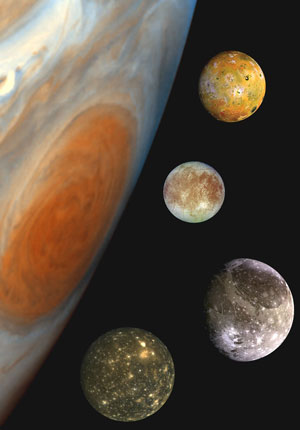New search for life among Jupiter’s ice moons
By Aidan Claire
17 May 2012
The European Space Agency (ESA) has announced a €1.1 billion unmanned mission to the ice moons of the planet Jupiter. A robotic spacecraft, named the JUpiter ICy moons Explorer (JUICE), is set to launch in 2022 and arrive at Jupiter in 2030. It will study Europa, Callisto and Ganymede, three of the four “Galilean satellites,” named after the Galileo Galilei, who first observed them in 1610.
 Artist’s impression of Jupiter Icy Moons Explorer
Artist’s impression of Jupiter Icy Moons Explorer[Credits: ESA/AOES]
“JUICE will give us better insight into how gas giants and their orbiting worlds form, and their potential for hosting life,” explained the ESA Director of Science and Robotic Exploration, Professor Alvaro Giménez Cañete.
The ESA mission objectives include discovering whether the moons support life or could indicate the existence of “potential habitats” on other exoplanets—planets that orbit other stars.
JUICE will fly by Europa and Callisto and finally settle in orbit around Ganymede, the main focus of the mission. It is the largest moon in the solar system (larger than the planet Mercury) and the only one known to have a magnetic field.
The European mission will follow the Juno spacecraft, launched by the US National Aeronautics and Space Administration last August, and due to arrive in Jupiter orbit in 2016 for a year-long mission focused mainly on the giant planet itself.
Jupiter is 780 million kilometres from the sun, five times further away than the Earth, so its moons are cold, with surface temperatures of -160°C (Europa), -108°C (Callisto) and -173°C (Ganymede). However, these inhospitable ice surfaces are believed to be a crust covering over large warm liquid oceans, which are kept from freezing by hot inner cores and gravitational stresses.
Professor Michele Dougherty told BBC News that solar bodies don’t need to be close to a star to be habitable and that it is predicted that the key factors required for life—water, heat, a long period of stability and a mix of key organic elements (nitrogen, carbon, hydrogen)—are present in Jupiter’s ice moons.
 Family portrait of Jupiter’s great red spot and the
Family portrait of Jupiter’s great red spot and the Galilean satellites from top to bottom, Io, Europa,
Ganymede and Callisto
[Credit: NASA Solar system Collection]
The mission will not involve landing on the moons, so observations and studies will be from a distance. Kevin Hand from NASA’s Jet Propulsion Laboratory told National Geographic how onboard radar will be used to probe beneath the ice and the chemical composition of the water below and reveal the structure of the moons.
JUICE was chosen from a group of three potential “large-class” projects, with the Advanced Telescope for High Energy Astrophysics (ATHENA) and the New Gravitational wave Observatory (NGO) missing out. Giménez Cañete explained, “It was a difficult decision to choose one mission from three excellent candidates. All three would produce world-class science and put Europe at the forefront of space research.”
The fact that the ATHENA and NGO projects, which address fundamental science and are equally deserving of funding have been sidelined, is an indictment of the current economic situation and the illogical allocation of wealth. In addition, the scope of the JUICE mission has been severely cut back because NASA’s contribution, focussing on Europa, has been cancelled due to budget cuts at the US agency.
Questions hang over future funding of ESA. Currently, it has 19 members which fund its €4.02 billion 2012 budget. The majority of these countries are in the process of slashing public spending as a direct result of the billions of euros handed over to the European banking cartels.
Physics World in May reports that Spain has cut its research budget by 26 percent due to the government’s austerity drive, a massive €2.3 billion reduction. This cut will mean that Spain will renegotiate its contributions to joint international and European projects like European Organisation for Nuclear Research (CERN) and ESA.
One hears repeatedly debated in the mass media whether space exploration and the questions of fundamental physics are a “waste of money” and that the resources of these projects would be better used elsewhere. These phony debates are manipulated to give reactionaries a platform to rail against fundamental large-scale research to create an ideological climate in which it is acceptable for important scientific research to be cut.
In reality the annual net profit of a corporation like Wal-Mart is $17 billion (€13 billion) and would pay for 13 trips to Jupiter.
While the JUICE mission is one of ground-breaking research probing the possibility of life in our own solar system and countless others, it remains very precarious while economic life is controlled by a parasitic elite who reap massive fortunes and slash social spending.
There is a very real risk that JUICE will fall victim to budget cuts, which will force delays, as in the case of the International Thermonuclear Experimental Reactor, ITER for fusion research, or scrapped altogether, like NASA’s moon return project, Constellation, cancelled in 2010. This would add to a long balance sheet of fundamental research that is being sabotaged by concern for capitalist profit margins, thus retarding the march of human progress.





Follow the WSWS